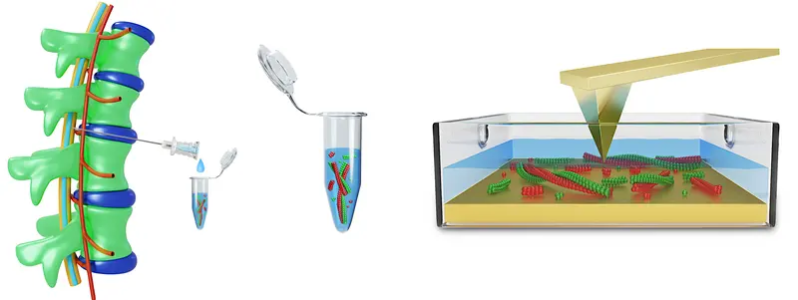Amazing breakthrough: Protein size could lead to early Alzheimer's detection and better treatment
As we grow older, it’s only natural to become more mindful of our health and well-being, particularly when it comes to things like cognitive decline. A significant concern amongst seniors is Alzheimer's disease, which is a neurodegenerative condition affecting memory and cognitive functioning. While modern medicine has made leaps and bounds in diagnosing and treating various health issues, Alzheimer's disease remains a challenge.
Thanks to a groundbreaking new discovery, however, researchers may now have found the key to earlier detection and improved treatment of Alzheimer's—and it all comes down to the size of certain proteins. The Seniors Discount Club is excited to share this potentially game-changing finding with our members.

A depiction of a twisted mass of proteins, which causes the demise of nerve cells and is a characteristic feature of Alzheimer's disease. Source: EMPA/Communications Biology
When it comes to diagnosing Alzheimer's, the standard procedure involves testing for protein clumps in the patient’s cerebrospinal fluid (CSF). This method, while helpful, does not provide information on how much the disease has progressed, leaving patients and doctors with limited information.
In the groundbreaking research, scientists at the Swiss Federal Laboratories for Materials, Science and Technology (EMPA) utilised atomic force microscopy (AFM) to visualise clumps of 'fibrils' formed by tau and amyloid-beta proteins in CSF, both of which are known to play a role in Alzheimer's development. By carefully examining the fibrils' size, structure, and shape, the researchers were able to establish a connection between particular morphologies and the disease's various stages.

It turns out that only short protein fibrils, around 100 nanometres in length, were found in people in the early stages of Alzheimer's. As the disease progressed, longer fibrils—up to several micrometres in length—became more prevalent. The CSF of healthy individuals contained extremely short fibrils (or none at all) compared with those observed in people with dementia.
This vital discovery is set to transform the way we approach Alzheimer's detection and treatment. By using AFM technology, health professionals can now better determine the disease's stage and possibly develop more effective therapeutic interventions, all thanks to our newfound understanding of the role protein size plays.
Lead author of the study, Peter Nirmalraj, remarked on the potential applications of this research, stating, 'AFM technology has the potential to complement conventional biomarker tests and improve the early detection of Alzheimer's.'
Additionally, the development of new diagnostics, such as atomic force microscopy (AFM), to detect Alzheimer's in its early stages has significantly improved the chances of early detection. This breakthrough not only sheds light on the disease but also opens doors for the development of new treatments for Alzheimer's, a condition that has yet to be cured.
Researchers are hopeful that these findings will pave the way for more advanced drugs and therapies to combat Alzheimer's in the future. Breakthroughs like this allow diagnostic tools and research studies to offer more complete information, which could contribute to the earlier identification of the disease and improved care for individuals with Alzheimer's.
Science keeps providing us with hope and solutions as we aim to live healthier, more fulfilling lives into our golden years. Our understanding of Alzheimer's disease is continually evolving, and this latest breakthrough in protein size research brings us a step closer to overcoming the heartbreaking effects of cognitive decline.
 As we continue to discover more about Alzheimer’s Disease and the challenges that come with it, it’s becoming increasingly important for seniors to stay informed about the latest developments in research and treatment. By staying up-to-date on the latest news, you can take proactive steps to protect your cognitive health and make the most of your golden years. That is why we encourage you to share your thoughts about this latest breakthrough! By doing so, you will help raise awareness, and you’ll also be able to connect with others who share the same passion as you. We can’t wait to hear from you!
As we continue to discover more about Alzheimer’s Disease and the challenges that come with it, it’s becoming increasingly important for seniors to stay informed about the latest developments in research and treatment. By staying up-to-date on the latest news, you can take proactive steps to protect your cognitive health and make the most of your golden years. That is why we encourage you to share your thoughts about this latest breakthrough! By doing so, you will help raise awareness, and you’ll also be able to connect with others who share the same passion as you. We can’t wait to hear from you!
Thanks to a groundbreaking new discovery, however, researchers may now have found the key to earlier detection and improved treatment of Alzheimer's—and it all comes down to the size of certain proteins. The Seniors Discount Club is excited to share this potentially game-changing finding with our members.

A depiction of a twisted mass of proteins, which causes the demise of nerve cells and is a characteristic feature of Alzheimer's disease. Source: EMPA/Communications Biology
When it comes to diagnosing Alzheimer's, the standard procedure involves testing for protein clumps in the patient’s cerebrospinal fluid (CSF). This method, while helpful, does not provide information on how much the disease has progressed, leaving patients and doctors with limited information.
In the groundbreaking research, scientists at the Swiss Federal Laboratories for Materials, Science and Technology (EMPA) utilised atomic force microscopy (AFM) to visualise clumps of 'fibrils' formed by tau and amyloid-beta proteins in CSF, both of which are known to play a role in Alzheimer's development. By carefully examining the fibrils' size, structure, and shape, the researchers were able to establish a connection between particular morphologies and the disease's various stages.

This is a representation of the process for extracting and analysing cerebrospinal fluid (CSF). Initially, spinal fluid is collected (on the left) and subsequently deposited onto a gold substrate within a liquid cell (on the right). The proteins (depicted in red and green) are then imaged using atomic force microscopy (AFM) technology (note that the image is not to scale). Source: EMPA/Communications Biology
It turns out that only short protein fibrils, around 100 nanometres in length, were found in people in the early stages of Alzheimer's. As the disease progressed, longer fibrils—up to several micrometres in length—became more prevalent. The CSF of healthy individuals contained extremely short fibrils (or none at all) compared with those observed in people with dementia.
This vital discovery is set to transform the way we approach Alzheimer's detection and treatment. By using AFM technology, health professionals can now better determine the disease's stage and possibly develop more effective therapeutic interventions, all thanks to our newfound understanding of the role protein size plays.
Lead author of the study, Peter Nirmalraj, remarked on the potential applications of this research, stating, 'AFM technology has the potential to complement conventional biomarker tests and improve the early detection of Alzheimer's.'
The Importance of Early Detection in Alzheimer’s Disease
The new insight into Alzheimer's disease, which allows for earlier and more accurate detection, is crucial because an early diagnosis allows individuals to access appropriate treatments, resources, and interventions before the symptoms become overwhelming. Early detection also enables individuals to become involved in decision-making about their care, preserve their independence for as long as possible, and receive treatment and support tailored to their needs and preferences.Additionally, the development of new diagnostics, such as atomic force microscopy (AFM), to detect Alzheimer's in its early stages has significantly improved the chances of early detection. This breakthrough not only sheds light on the disease but also opens doors for the development of new treatments for Alzheimer's, a condition that has yet to be cured.
Researchers are hopeful that these findings will pave the way for more advanced drugs and therapies to combat Alzheimer's in the future. Breakthroughs like this allow diagnostic tools and research studies to offer more complete information, which could contribute to the earlier identification of the disease and improved care for individuals with Alzheimer's.
Science keeps providing us with hope and solutions as we aim to live healthier, more fulfilling lives into our golden years. Our understanding of Alzheimer's disease is continually evolving, and this latest breakthrough in protein size research brings us a step closer to overcoming the heartbreaking effects of cognitive decline.
Key Takeaways
- In a new study, researchers were able to stage Alzheimer's disease using atomic force microscopy (AFM) to visualize the size and shape of protein clumps in spinal fluid, which may provide a way of detecting the debilitating disease earlier.
- Swiss Federal Laboratories for Materials Science and Technology (EMPA) researchers studied aggregated tau and amyloid beta protein bundles (called fibrils) in the cerebrospinal fluid (CSF) of people with Alzheimer’s disease.
- By analyzing the proteins’ size, structure, and shape and how they clump together, the researchers could link different morphologies to a particular stage of Alzheimer’s disease.
- The study's findings further expand our knowledge about how Alzheimer’s disease develops and provide a new, more precise biomarker to gauge how far the disease has progressed. AFM technology has the potential to complement conventional biomarker tests
and improve the early detection of Alzheimer’s.







